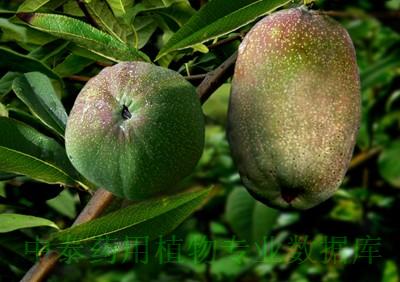| [English Name] | Chinese Floweringquice Fruit | |
| [Chinese Name] | 木瓜 | |
| [Pinying Name] | Mugua | |
| [Latin Name] | Chaenomelis Spceiosae Fructus | |
| [Genera] | Rosaceae | |
| [Efficacy] | qufengshiyao | |
| [Pictures] | Plant picture | Drug picture |

|
|
|
| [Alias] | ||
| [Source] | ||
| [Plant morphology] | ||
| [Distribution] | ||
| [Gathering and processing] | ||
| [Characteristics] | ||
| [Ecology] | Chinese Floweringquice Fruit prefers warm and moist climate, resistants to cold,doesn’t resistant to drought.There is no strict demand of soil,but the optimal soil for growing is sunny、fertile、thick alluvium. Chinese Floweringquice Fruit is biennial branches into flower, result rate of 2 or 3 years stouting short branch is higher. |
|
| [Chemical composition] | ||
| [Pharmacological activities] |
1. The extract of Chinese quince has the inhibiting effect on H22 tumor, and could upgrade significantly delayed-type of hypersensitivity, serum hemolysin content, macrophage phagocytosis, nature killer cells activity of tumor-bearing mice, which indicate that they could increase immune function in tumor-bearing mice. Meanwhile, the extract, could enhance the content of SOD and decrease the content of MDA in tumor-bearing mice serum, so they also have antioxidant effect on tumor-bearing mice[1]. 2. The glycosides isolated from Chaenomeles speciosa has the effects on anti-inflammation and analgesia[2] 3. The glucosides of chaenomeles speciosa could inhibit mice contact hypersensitivity reaction and resume the balance of T lymphocytes subsets in mice thymus with contact hypersensitivity, and also could modulate the cytokines production by CD4 + T lymphocytes of contact hypersensitivity mice[3]. 4. The ethanol extracts of Chaenomeles speciosa could decrease the levels of ALT, AST, GGT and ALP in the blood of rats, which shows ethanol extracts has the effects on protecting liver and decreasing enzyme[4]. |
|
| [Clinical trial] | Mugua (Chaenomeles) 1 Acuteicteric hepatitis: Taken granules of mugua(Chaenomeles) ( each package contains crude drug 5g ), 3 times a day, 1-2 packageseach time, observed 70 cases, it had a significant effect on improving the symptoms, signs and liver function[1]. Take theliver-soothing infusion of mugua, 3 times a day, each time 15g. Treated 172 cases,the effective rate was 95.1% [2]. 2 Acute bacillary dysentery:Taken tablet of mugua(Chaenomeles) (0.25g each piece),3 times a day, each time 5 pieces, 5-7 days as a course of treatment. Treated 107 cases, the effective rate was 96.28%. The cure rate was 85.98%[3]. 3 Chronic pharyngitis: mugua (Chaenomeles) 10-15g, decoction instead of tea drink, several times a day, 1 mouth as a course of treatment, take 3 courses. Treated37 cases, the effective rate was 81.78% [4]. 4 Athlete's foot: mugua and gancao 300g respectively, soak inthe mature vingar for 4h. Soak the disaster foot into the medicine juice for 1h, 2times a day, 8 times as a course of treatment. Treated 58 cases, all effective,48 cases were cured [5]. |
|
| [Properties] | ||
| [Medical and other Uses] | ||
| [Dosage] | ||
| [Cautions] | ||
| [Traditional usage] | 1.Measles 2.Carbuncle and furuncle induced by toxin 3.Numbness caused by invasion of damp-wind 4.Colic below umbilicus 5.Tinea pedis caused by damp-heat 6.Internal hemorrhoid | |
| [Toxicological studies] | ||
| [Pharmaceutical preparations] | ||
| [References] |
Pharmacological actions: [1] WANG Zhi-fang. Determination, Extraction, Antitumor Activity of Oleanolic Acid and Ursolic Acid from Chinese Quince. Huazhong Agricultural University, 2006. [2] WU Hong, DAI Min, WEI Wei, et al. Pharmacological effects of different solvent extract of Chaenomeles speciosa. Chinese Journal of Traditional Medical Science and Technology, 2004,11(2):98-99. [3] ZHENG Yong-qiu,WEI Wei, DAI Min, et al. Glucosides of Chaenomeles speciosa suppressed contact hypersensitivity response via modulating the thymus T lymphocytes subsets in mice. Chinese Pharmacological Bulletin, 2004,20(9):1016-1020. [4] Wang Hong-xian. Lab Study of Effects FRUCTUS CHAENOMELES on Protecting Hepar and Decreasing Enzyme. World Journal of Integrated Traditional and Western Medicine, 2007,2(4):213-214. [1]Zheng Zhimin. Clinical efficacy analysis of Chaenomeles granules in treatment of theacute jaundice viral hepatitis. Traditional Chinese Medicine of Fujian,1987,(2):24. [2]Tian Qiwei. Efficacy analysis of treatment of acute icterichepatitis with comfortable liver granule of Chaenomeles. Chinese herbal medicine, 1989,(2):4. [3]A clinical investigation of treatment of acute icteric hepatitis with Chaenomeles in 107 cases.Chinese Medicine, 1984,(11):689. [4]Li Dongzeng .ClinicalObservation on Treating 37 cases of chronic pharyngitis with Single papaya, Traditional Chinese Medicine of Sichuan,1999,(6):49. [5]Deng Yan. Treating 58 cases of athlete'sfoot with Papaya vinegar. Chinese folkmedicine, 1997,(2):45. |
|